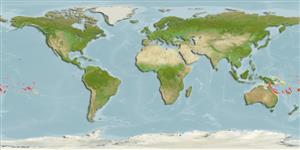>
Blenniiformes (Blennies) >
Tripterygiidae (Triplefin blennies) > Tripterygiinae
Etymology: Enneapterygius: Greek, ennea = nine times + Greek, pterygion = little fin (Ref. 45335).
More on author: Fricke.
Environment: milieu / climate zone / depth range / distribution range
पारिस्थितिकी
समुद्री प्रवाल-भित्ति संयुक्त; गहराई सीमा 0 - 17 m (Ref. 13227). Tropical
Southwest Pacific: Australia, Vanuatu, Fiji, then east to American Samoa, and the French Polynesia.
आकार / वज़न / Age
Maturity: Lm ? range ? - ? cm
Max length : 4.5 cm SL पुल्लिंग / अलिंग; (Ref. 54980)
Short description
आकृति विज्ञान | मौरफोमैटरिक्स
पृष्ठीय रीढ़ (सम्पूर्ण): 14 - 17; पृष्ठीय सौफट रेज़ (सम्पूर्ण): 7-11; गुदा कांटा 1; ऐनल सौफट रेज़: 17 - 21. Small and slender supraorbital tentacle; in males, first spine of first dorsal fin higher than first spine of second dorsal fin; in females, first dorsal fin a little less than 50% shorter than second dorsal fin; females whitish, with fine black dots, bearing a reticular red or brown pattern, isolating the white into 2-3 longitudinal rows of blotches; male coloration similar but generally darker. Dorsal rays III + XI-XIII + 7-10; lateral line interrupted, 14-20 + 14-21; mandibular pores 3-4 + 1 + 3-4 (Ref. 54980).
Female members of the Tripterygiidae have eggs that are hemispherical and covered with numerous sticky threads that anchor them in the algae on the nesting sites (Ref. 240). Larvae are planktonic which occur primarily in shallow, nearshore waters (Ref. 94114).
Life cycle and mating behavior
परिपक्व अवधि | पुनरुत्पत्ति | मछलीऔ का अंडे देना | अंडे | Fecundity | लार्वा
Fricke, R., 1994. Tripterygiid fishes of Australia, New Zealand and the southwest Pacific Ocean (Teleostei). Theses Zool. 24:1-585. (Ref. 13227)
IUCN Red List Status (Ref. 130435)
Threat to humans
Harmless
Human uses
मात्स्यिकी: कोई रुचि बग़ैर
अधिक जानकारी
आम नामउपशब्दचपायचयपरभक्षीईकोटोकसीकोलौजीपुनरुत्पत्तिपरिपक्व अवधिमछलीऔ का अंडे देनाSpawning aggregationFecundityअंडेEgg development
Age/Sizeबाढ़Length-weightLength-lengthLength-frequenciesमौरफोमैटरिक्सआकृति विज्ञानलार्वालारवल गतिकीभर्तीबहुतायतBRUVS
संदर्भजलीयकृषिजलीयकृषि रूपरेखाखींचआनुवंशिकीElectrophoresesहैरेटिबिलटीबीमारीप्रक्रमणNutrientsMass conversion
सहयोगीयोतस्वीरेStamps, Coins Misc.ध्वनिसिगुयटिरारफ्तारतैरने के प्रकारगिल क्षेत्रOtolithsदिमागदृष्टि
साधन
Special reports
Download XML
इंटरनेट स्रोत
Estimates based on models
Preferred temperature (Ref.
123201): 25 - 29, mean 27.1 °C (based on 457 cells).
Phylogenetic diversity index (Ref.
82804): PD
50 = 0.5000 [Uniqueness, from 0.5 = low to 2.0 = high].
Bayesian length-weight: a=0.00562 (0.00258 - 0.01228), b=3.08 (2.89 - 3.27), in cm total length, based on LWR estimates for this (Sub)family-body shape (Ref.
93245).
Trophic level (Ref.
69278): 3.2 ±0.3 se; based on size and trophs of closest relatives
लौटाव (Ref.
120179): ऊंचा, न्यूनतम जनसंख्या दुगनी समय अवलागत 15 महीने। (Preliminary K or Fecundity.).
Fishing Vulnerability (Ref.
59153): Low vulnerability (10 of 100).
Nutrients (Ref.
124155): Calcium = 371 [165, 1,059] mg/100g; Iron = 1.83 [0.77, 3.67] mg/100g; Protein = 18.3 [16.8, 19.8] %; Omega3 = 0.102 [0.036, 0.307] g/100g; Selenium = 47 [13, 150] μg/100g; VitaminA = 56 [11, 275] μg/100g; Zinc = 4.02 [2.07, 6.83] mg/100g (wet weight);
